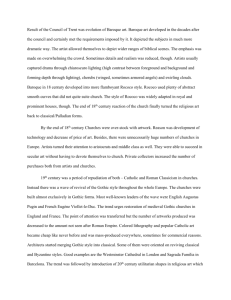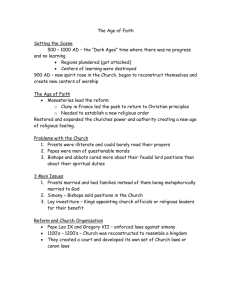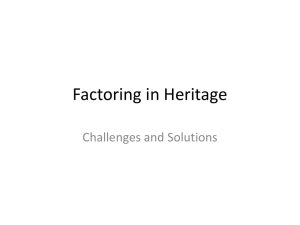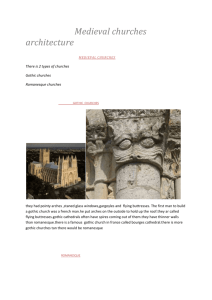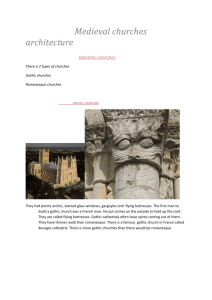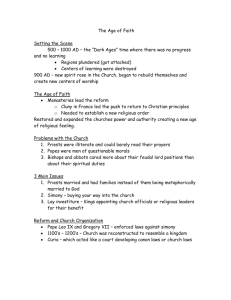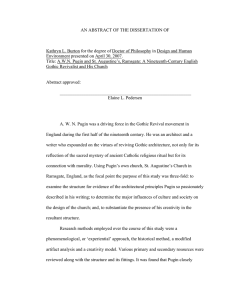Torquay, London, Gloucester, Cheadle, Manchester
advertisement
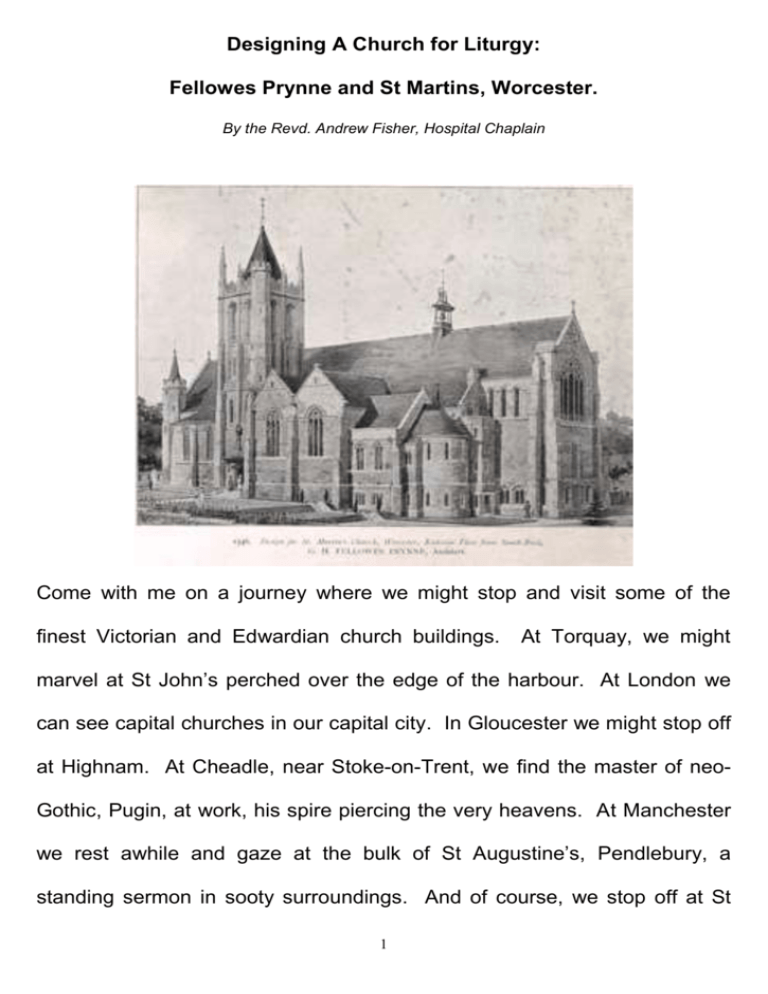
Designing A Church for Liturgy: Fellowes Prynne and St Martins, Worcester. By the Revd. Andrew Fisher, Hospital Chaplain Come with me on a journey where we might stop and visit some of the finest Victorian and Edwardian church buildings. At Torquay, we might marvel at St John’s perched over the edge of the harbour. At London we can see capital churches in our capital city. In Gloucester we might stop off at Highnam. At Cheadle, near Stoke-on-Trent, we find the master of neoGothic, Pugin, at work, his spire piercing the very heavens. At Manchester we rest awhile and gaze at the bulk of St Augustine’s, Pendlebury, a standing sermon in sooty surroundings. And of course, we stop off at St 1 Martin’s, Worcester: a work of ecclesiastical, architectural brilliance. You might be wondering why a hospital chaplain is waxing lyrical about Victorian and Edwardian churches. Well, like me, let’s have some patience (patients!) and I will explain. Ever since I was a child I was fascinated by church architecture. My mum and dad weren’t particularly religious, in fact my dad was quite antireligious, but back where I lived in the Holy Land – Derbyshire - our local parish church had a particular attraction. The church, in a mining town called Alfreton, was the usual medieval affair, built out of blackened mill stone. Set against its blackened tower face was a lovely black and white clock. And this clock used to fascinate me as I was being pushed around in my push chair on the way to the nearby park. In fact, with me pointing up at the church tower and that lovely black and white clock, ‘clock’ was one of the first words that I learnt to say, much to the disappointment of mum and dad. That fascination of church architecture never left me. As a boy I devoured Ladybird books on what to look for inside a church and what to look for outside a church. As a snotty teenager, I bored the pants off vicars and their churchwardens as they unlocked their, sadly, locked churches and let me look around. 2 As the title of my paper suggests, I want to talk about Victorian and Edwardian church architecture and design and I want to talk about George Halford Fellowes Prynne who designed St Martin’s in Worcester. Just as importantly, I want to say something about why I think churches are special and I want us to think about what church buildings are for. But more about that later, because first of all I want us to go on another journey. Not across our green and pleasant land again, this time I want us to journey back in time; back to the very beginning of the great nineteenth century boom in church building. The date is 1818, and the Church Building Society has just been set up. Parliament, who had a bit more money and a bit more faith in those days, voted a million pounds for the building of new churches and they set up a commission to deal with the matter. The government made another grant in 1824, and that was the last time that the Church of England received any such help from the State. The new churches that were built were called Commissioner’s Churches, or Waterloo churches, because of the recent Napoleonic Wars. These were tumultuous times in Europe and the more well-to-do folk in England were worried that the plebs might revolt like they had done across the channel. 3 The well-to-do Church of England was also worried because if the plebs were not yet plotting revolution, they were certainly becoming Baptist or Methodist or whatever, and leaving poor Mother Church behind. Both the Church of England and the government thought that in building more churches this tide could be stemmed and the public put back on a more even keel. So the Commissioners Churches were built, and to advertise their presence in the growing towns and cities, many of the Commissioner’s churches made a grand show with tall pinnacles and fancy towers. Many of the Commissioners churches were deliberately built on hills. Here they could dominate their surroundings. Close to Worcester, some grand Commissioners Churches include St George’s in Kidderminster and St James in Dudley. Many of the parish churches in Stoke-on-Trent are Commissioner’s Churches. They were designed to seat as many folk as possible for the least amount of money. And to give an idea of what could be achieved, some of the Commissioner’s churches in Stoke-on-Trent can comfortably seat two thousand folk, much more than can be seated, say, in Lichfield cathedral. 4 The Commissioners churches were designed in either the Greek or Gothic style. It didn’t seem to matter which, although a Gothic church did not have to have great classical columns and pediments and so they were cheaper to build. Regardless of style, liturgically, Commissioner’s churches were built as great barns for preaching in; the altar and any sanctuary furniture were quite subsidiary. The parish choir, if churches had one, were tucked away into a gallery. The sermon was the important thing and preachers were exalted in their huge pulpits six, seven or even eight foot above contradiction. The Commissioner’s churches were the flagship buildings of the early Victorian Church of England, but as pieces of church design the Commissioner’s churches had their drawbacks. They did their job as church buildings but even the very best of them, by the very best of church architects, have a papery feel about them. Their architecture is too regular, too taught, too nervous in handling. The details look stuck on, rather than an integral part of the building. The slender pinnacles might blow away in the faintest of breezes and the tapering towers might topple in the slightest of gales. I always get the feeling that St George’s in Kidderminster could slip down the hill into the bypass at any given moment. 5 In the end it wasn’t the papery architecture or the wind that did away with the Commissioner’s churches. It was a trumpet blast from one man, and interestingly not a man from within the Church of England. That man was Augustus Welby Northmore Pugin, and for church architecture and church architects, Pugin’s vehemence and Pugin’s pen was far mightier than any sword. It was far sharper and more pointed too! Pugin’s polemic was as forceful and grand as his name suggests. Pugin was the son of a French draughtsman, Augustus Charles Pugin. Pugin senior trained the younger Pugin as a boy to draw Gothic buildings for use as illustrations in his books. From an early age, Pugin showed a precocious talent for design. Aged 15 he went to work designing Gothic furniture for royalty at Windsor Castle. Nice work if you can get it. Aged 17 Pugin began supplying furniture and ornamental carved work for houses throughout the kingdom and in 1833, Pugin began working with Sir Charles Barry, who had previously designed Commissioners Churches. In 1835 Pugin helped Barry design and win the competition for the new Houses of Parliament. Barry was a master at drawing plans but he could not do authentic Gothic detail. Pugin could, and all the Gothic stonework, all the Gothic fixtures and fittings are by him, even down to the Gothic ink stands in the House of Lords. 6 Following this lucrative commission, Pugin built his first house and he was received into the Roman Catholic Church. In 1836, Pugin published his first tract, Contrasts; or a Parallel between the Noble Edifices of the Fourteenth and Fifteenth Centuries and Similar Buildings of the Present Day: Showing the Present Decay in Taste. Nothing like Contrasts had been seen before, and it caused an outcry. In its pages, Pugin berated Victorian society and the buildings that represented it. The workhouse system was set against how the monasteries used to care for the poor. Gimcrack Gothic and Greek buildings like the Commissioner’s churches were slammed. Nothing was done properly, nothing was built properly. Society’s morals were poor, and so were the buildings society built. “The degraded state of the arts in this country”, Pugin ranted, “is owing to the absence of catholic feeling among its professors, the loss of ecclesiastical patronage, and the apathy with which a Protestant nation must necessarily treat the higher branches of Art!” However, the real driving force of Contrasts was not Pugin’s words, but rather his pictures which illustrated it. Pugin proved his point again and again by setting side by side a drawing of a medieval building and a contemporary one and the reader’s flesh could not fail to creep at the 7 contrast. In one picture there is a complete medieval town, with its Gothic churches and Gothic abbeys and Gothic crosses. In the next picture of the same town in 1840 there are no abbeys, only mutilated churches, several Grecian Free Church chapels, a gasworks and a Grecian lunatic asylum. An interested Irishman, Mr M’Cann wrote this poem after reading Contrasts: Oh, have you seen the work just out by Pugin the great builder? ‘Architectural contrasts’ he’s made out poor Protestants to bewilder. The Catholic Church, she never knew, ‘till Mr Pugin taught her, that orthodoxy had to do at all with bricks and mortar. But now its clear to one and all since he’s published his lecture, No Church is Catholic at all without Gothic architecture. In fact he quite turns up his nose at any style that’s recent. 8 That Grecian too, he plainly shows is wicked and indecent. By 1841, Pugin views had begun to be accepted and Pugin had begun to build churches for the Roman Catholics. With this he lay down the gauntlet for church architects of all denominations. On a roll, Pugin published his next polemic, True Principles of Pointed or Christian Architecture. In True Principles, Pugin set forth two great rules of church design: First, that there should be no features about a building which are not necessary for convenience, construction and propriety. Second, that all ornament should consist of enrichment of the essential construction of the building. The neglect of these rules (Pugin said) is the cause of all the bad architecture of the present time. 9 The ailing architects of the Commissioner’s Churches had thought of the Gothic style chiefly in terms of ornament. Conversely, Pugin preached that the essence of Gothic was in its very construction. Pointed arches are not only beautiful, but they are more secure than semicircular arches. Stone vaults were not only more pleasing to look at than a wooden roof, they were fireproof. Buttresses were developed not only because they give a sense of rhythm to a wall but because they allow for less wall and more window. And Pugin also preached that Gothic was above all, Christian architecture. This style belonged to no other faith, it was designed for Christian liturgy, and now the churches and the church architects had to listen. Pugin pictured noble churches, with spires pointing to heaven and niches filled with saints and angels. In his imagination he entered their doors and gazed at their twinkling points of light and the glowing pictures in the stained glass. There were altars and screens and metal work and tiles. There were beautiful priests in beautiful vestments leading beautiful liturgy. The churches and the architects slowly but surely took Pugin’s outstretched hands and they walked with him and followed him through this architectural, ecclesiastical romance. After reading Pugin’s books and meeting the man once, a fellow architect said, “It is like I have come from a dream. I had not then awakened to the viciousness of shams; I was unconscious of the 10 abyss into which I had fallen.” Very few churches were built after Pugin that were not Gothic. It was the Church of England who first picked up Pugin’s gauntlet and, like they were making up for lost time, the C of E ran with it. In May, 1939 the Camden Society was formed as a club for Cambridge undergraduates who shared a common interest in Gothic church design. The Camden Society’s first activity was to collect information about churches across the country. The Society amassed so much information about medieval parish churches that it soon came to be seen as the authority on church buildings. This accolade was not misplaced and the Society’s vigour in examining and defining every detail of the medieval church was enormous. The Society’s magazine, the Ecclesiologist, began to encourage and publish heated debates. Should churches by orientated true east or not? Which period of Gothic is the right style to use? What was the function of small openings called lychnoscopes? If you know, friends, answers on a postcard, please! Like Pugin, the Camden Society fostered the unshakeable belief that humanity could only regain the perceived piety of the Middle Ages by imitating them. “We know that medieval Catholic ethics gave rise to Catholick architecture” wrote the Ecclesiologist, “may we not hope that, by a 11 kind of reversed process, association with Catholick architecture will give rise to Catholic ethics?” In 1841, the same year that Pugin published his True Principles, the Camden Society published a pamphlet entitled A Few Words to Churchbuilders, laying down their own doctrines about what a church should be. The pamphlet reads a bit like a cookery book. The authors recommended an Early English Gothic style for small chapels, but Decorated or Perpendicular Gothic for larger churches. Like the Camden Society, we will be relieved to know that St Martin’s in Worcester is a Decorated Gothic church. The two essential parts of a church were the nave, and a welldefined chancel not less than a third of the length of the nave. Aisles were recommended, because a tripartite church symbolised the Holy Trinity, but a single aisle was acceptable, if that was all funds permitted. A tower could be in any position, except over the altar, that would be sacrilege, but it was not essential. Stone should be used, preferably not brick, but flint was acceptable too. The chancel to be was strictly for the clergy. It should be raised at least two steps above the nave, and the altar should be raised higher still. The chancel and nave should be separated by a roodscreen, "that most beautiful and Catholick appendage to a church" according to the 12 authors. The authors also had a liking for sedilias and aumbries. The font must be in the nave, they said, and near a door. Seating should not be in closed pews, but open benches or chairs, and galleries were anathema. The popularity of the Camden Society’s handbook soon led some zealous church-wardens to seek advice on how to restore their dilapidated old buildings or their embarrassingly out of date Commissioner’s churches. These solicitations were answered with equal enthusiasm and the Society’s mission changed from mere antiquarianism to architectural consultation. As their mission changed, so did The Ecclesiologist, which soon began to publish architectural criticism, as vehement and sharped tongued as ever Pugin was. In its hey day The Ecclesiologist reviewed over one thousand churches and never hesitated to lambast both a building and its architect for anything inconsistent with its views. A write up could literally make or break an architect. Interestingly, The Ecclesiologist’s verdict on an architect’s work was determined as much by the architect’s personal life as his building design. Although Pugin was the pioneer of the Gothic revival and had similar tastes 13 to those of the Camden Society, he was slammed for his Roman Catholicism. Subsequently, Pugin fell out of favour and became seen as an eccentric. Likewise, the Ecclesiologist says of Thomas Rickman, a Quaker and architect of St James’, Hartlebury, “Many have really felt it a stumbling block that a person of Mr Rickman’s religious persuasion should be regarded as a benefactor to Christian Art” and “he did very little…and his churches are monuments of extreme ecclesiological ignorance.” By now very self-assured, the Camden Society went on to publish books such as the Hierugia Anglicana, which sought to prove that medieval Catholic ritual had lived on in the Church of England past the Reformation and was therefore the proper way to worship. Its most important work was The Symbolism of Churches and Church Ornaments, also known by the name of the medieval bishop who inspired it, Durandus. In this book, the authors argued that absolutely every architectural element of the medieval church building was religiously symbolic. They sought to prove that Gothic churches represented a Christian piety and thought well above that of the 19th century: “Is it possible,” the authors said, “to conceive that the Church which invented so deeply symbolical a system of liturgy should have rested 14 content with an unsymbolical building for its practice?” Their argument complete, the rest of the book goes on to give examples of symbolism: Symbols of the Holy Trinity 1. The triple division of nave, chancel and sanctuary 2. The arrangement of arcade, triforium and clerestory 3. The altar steps 4. The triple division of the windows, placed at the east of the church. 5. The numbers three and six The Atonement is symbolised by a cross shaped plan and gable crosses The communion of saints is symbolised by monuments and a lady chapel Windows symbolise the light of the world A circle typifies the crown of the King of Kings A window of two lights represents the two natures of Christ, or the mission of the disciples two by two Doors symbolise Christ as the Door, and the entrance through much tribulation into the Kingdom of God Pointed arches represent the hands in prayer 15 The list goes on. At the close of the book the authors proclaimed that church architects must “take a religious view of their profession” and that “we do protest against the merely business-like spirit of the modern profession, and demand from them a more elevated and directly religious habit of mind.” And with that in mind we must think a little about the architect of St Martins. George Halford Fellowes Prynne was born on April 2nd 1853 at Wyndham Square in Plymouth. George was the second son of the Reverend George Rundle Prynne and Emily Fellowes. As well as his elder brother, Edward Alfred, he had a brother, Albert Bernard, and two sisters. His father was a well-known figure in religious circles of the time, being outspoken in his support of high churchmanship in the Anglican Church, and espousing the views of both the Oxford Movement and the Camden Society. We have very little information about George Fellowes Prynne’s childhood. But he cannot have failed to be influenced by his father’s constant striving and indomitable spirit. Prynne senior was heavily involved in education, ministry to the sick, supporting the poor and preaching the gospel. George junior was sent away to school, first of all to St. Mary’s College, Harlow. He went on to Chardstock College, and then to Eastman’s Royal 16 Naval academy at Southsea. An impression of his life as a young man can be obtained from Fellowes Prynne’s own notes, which were current on his 44th birthday in 1897. It is clear that architecture was not a profession that he had really thought about. Instead he had spent time studying privately with a tutor near Oxford, with a view to becoming ordained but, as Fellowe’s Prynne puts it “…difficulties arose as to the expense of a University education.” Fellowes Prynne only became interested in architecture when his brother Edward was aiming to enter the office of George Edmund Street, the famous London architect and designer of the grand church of St John’s, Torquay. Little did Fellowes Prynne know at that time what an important influence that eminent architect was to have on his life. From his notes we can let Fellowes Prynne take up the story: At the age of 18….an offer came from an uncle, to get me a berth with a nephew of his who had taken land, and was farming in the Western states of America. I started on my new life’s career. The experience of Western farming life was both trying and severe, especially during the last nine months of the nearly 2 years spent in the then wild West. 26 years ago the 17 states of Iowa and Nebraska presented a very different aspect to what they do at present…. It was in these parts that one got one’s first experience in practical building, from log houses and barns, to a more respectable kind of brick and wooden house. It was here that I was initiated into the Mysteries of door and window-sash making – rough, but strong and practical. Seeing the uselessness of throwing my life away in these parts, and that few Englishmen succeeded in making more than a bare living, and yet not wishing to return home like a bad penny, I started for Canada, landing at St. Catherines in winter of 1872, but I could obtain no employment. So I went on to Toronto, where I obtained temporary work in the office of an architect in the small way of business, but later on, through the introduction of the Rev. Darling upon whom I had called, I got a place of Junior Assistant in the office of one of the best known Toronto architects, R. C. Windyer, who was at the time carrying out new Custom House buildings for the government. The terms of my employment were to work for what I was worth, and very little it must have been at the time, considering that my only credentials were my natural taste for drawing and my experience in the Wild West. But 18 work I did for dear life…. With the kindness and sympathy that it would be hard to exaggerate, Mr. Windyer helped forward my studies giving me the use of his library and drawings…. By January 1875 I had gained a senior position in the office, and it was shortly after that my father received an offer from the late George Edmund Street R.A., to take me into his office. I may here remark as a point of interest that my father gave Mr. Street his first church, and that he (Mr. Street) had often expressed his gratitude to him for giving him this start, as the immediate outcome was 3 other churches in Cornwall. On my return from America I worked in Mr. Street’s office during 1875 and 1876, in after years, working with Swinfern Harris, R.J. Withers, A. Waterhouse R.A., and at the London School Board offices. I was a student at the Royal Academy 1876 and 77-78. Fellowes Prynne went on to set up in his own practice in 1880, stating that his first work “of importance” was the building of his father’s church, St. Peter’s in Plymouth. The sanctuary, which was already built, was by George Street, and so the link between Street and Fellowes Prynne continued. Fellowes Prynne went on to design many parish churches in 19 England, mostly in the South East and South West, but always Gothic and always on a grand scale. The foundation stone for St Martins, was laid on Saturday 9th October 1909. Fellowes Prynne also did much restoration work. All in all he is said to have been involved in over 200 buildings! Pugin and the Camden Society looked for good Christian men to design good Christian churches and George Fellowes Prynne was a deeply religious man. Family prayers were said daily for the whole household and I think its fair to say his deep sense of faith is communicated in his buildings. Fellowes Prynne was also totally dedicated to his family, and his family life was not without tragedy. He never recovered from the loss of his sons, Edgar and Norman in the First World War and serious injuries suffered by his other sons Aubrey and Harold. His work shifted following the war to almost exclusively war memorials, right up to his death on the 7th May, 1927. Sir Edward Clarke wrote Fellowes Prynne’s obituary in the magazine of St Peter’s in Staines. It says a lot about the man, his character and his work, and as we hear these words we might just take a moment to look around this church, created by the same genius: In Memoriam GEORGE FELLOWES PRYNNE 20 All who are, or at any time have been, interested in our beautiful Church, will have heard with regret of the death of its gifted architect. George Prynne was the eldest son of the revered and beloved Father Prynne, who was for fifty years vicar of St. Peter’s, Plymouth. For twenty of those years he was my kind and faithful friend, and when the time came for the division of the Parish of Staines, and the building of a new Church, it seemed natural that the name of St. Peter should be used here, and that the son of my old friend, who had already at Plymouth and at Budleigh Salterton shown a special capacity for ecclesiastical architecture, should be entrusted with the duty of designing the new building and superintending its erection. He performed that most congenial task with a skill that amounted to genius, and an untiring diligence in supervising every detail of the work, even the dossal and frontal and the sanctuary kneelers and cushions were designed by him. And his success at Staines had not a little to do with him being afforded subsequent opportunities of showing his great qualities as an architect. At Roehampton, Dulwich, Bournemouth, Worcester and Ealing there are notable examples of his skill, at Columb [sic] there is a partially erected cathedral, which if completed according to his designs, will be a notable example of the expression in architecture of religious devotion. 21 His life and work were cruelly shadowed by the Great War. The building of beautiful churches appears for the time to have ceased. And two of his sons gave their lives for their country. Through it all he was a Christian gentleman; modest, kindly, diligent and patient. His brother, Edward, eminent in another form of devotional art, supplied the beautiful windows of our Church, and before his death, completed the designs for the windows still unfilled. And St. Peter’s stands as a worthy monument to the two brothers. George Fellowes Prynne was a model architect for his time, and he produced model churches. He was born into a time when Gothic had been heralded as the true architecture, as the true Christian architecture, and his beloved Church of England had seeded the country with spires and pinnacles, buttresses and pointed arches. George Fellowes Prynne was a good, Christian man and, as we can see here in St Martins, he could design beautiful churches, wonderful settings for the liturgy. But by means of a conclusion, I want to go back to the beginning of my talk, when I said a little about my childhood and my love of church buildings. As a teenager I continued to explore my fascination in church architecture. I 22 became a little obsessive as we might say Pugin did and the Cambridge Camden Society did. Once I learned how to drive and bought my first cars I used to set off around the Holy Land – Derbyshire - and around Staffordshire where I was at polytechnic. I used to spend time between lectures, and occasionally instead of lectures, visiting grand Victorian and Edwardian churches for their architecture. Out of all those churches, two stuck out in my mind. The first was Pugin’s gem at Cheadle, which I mentioned at the beginning, just outside of Stoke, with its 200ft spire pointing to the heavens like a holy missile. The other was Holy Angels at Hoar Cross, designed by George Frederick Bodley, a contemporary of Fellowes Prynne. Sitting on a little hill next to Hall Cross Hall, Holy Angels is a vision of Gothic splendour in stone. Both are outstanding buildings, but there was something else about those places. Standing inside these buildings, the prayers of the faithful were almost tangible, the presence of God could be felt, and that made a profound impression on me. Those two churches brought me to faith, not because of their architecture, as stunning as it is, but because of what those churches were for, because of who these churches were for, because of God. 23 There needs to be something more than having a world class architect design a church. There needs to be something more than whether our churches are Greek or Gothic in style, or are made out of brick or stone. They need to be prayed in, they need to be worshipped in. They need to invite us into presence of God and to bring us soonest to our knees. This is what we have here at St Martins, and this is what this building has witnessed to for a hundred years. As the good book says, and I don’t necessarily mean Contrasts or Durandus, I mean the Bible, “This is the house of God, this is the gate of heaven.” 24
